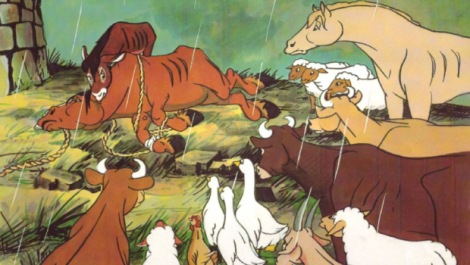Animal Farm

George Orwell’s savage 1945 satire on Soviet socialism provided the basis for Britain’s first-ever publicly screened feature-length animation. It’s an easily read allegory. The creatures of Animal Farm (i.e. Russia) suffer under the brutal tyranny of Farmer Jones (the Tsars). Inspired by aged prize boar Ancient Foremost (Karl Marx) they rise up, toss out the tyrant and set up a self-governing farm where ‘All Animals Are Equal’. An attack by Jones is seen off under the leadership of heroic pig Snowball (Trotsky) but jealous rival Napoleon (Stalin) has him killed. The animals soon find themselves slaving under a tyranny even worse than before, for ‘All Animals Are Equal – But Some Animals Are More Equal Than Others’.
The leading UK animators of the period, husband-and-wife team John Halas and Joy Batchelor stick pretty closely to Orwell’s original, despite simplifying the storyline and giving it a sort-of-pleased ending. The animation’s starker and more hard-edged than audiences of the time would have been used to, though here and there we get moments of Disneyesque whimsy and the odd cute duckling. But the power and rage of Orwell’s fable come through strongly, the characterisation is vivid and the battle sequences (there’s more than one attack on the farm) hit home with dynamic impact.
As it turned out, this was Halas and Batchelor’s only feature. The box-office was disappointing – parents expecting a tale of cuddly animals were appalled by the graphic violence. Still, Animal Farm wasn’t a perfect financial disaster: it later emerged that the project was secretly funded by the CIA, who saw it as a potent piece of anti-collectivist propaganda…
![]()












